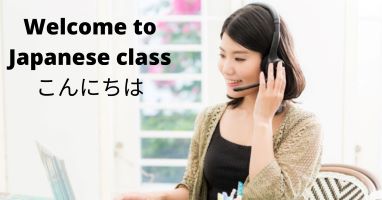7 Things You Need to Know about New Year in Japan
YOSHIKO BOWYER
Soon after Christmas, Japanese people quickly begin preparing for Oshougatsu (お正月/ New Year Day). It is not normal to keep Christmas ornaments after the 25th. As I mentioned in my previous post, Christmas does not have a religious meaning in Japan. In contrast, New Year in Japan is very much related to religion and has many family traditions.
Since New Year is very family-oriented, it might be tricky for visitors to experience the whole event, unless you have a local friend who invite you to their family home. However, I would like to explain some significant aspects that will help you understand the most important cultural event of the year.
#1. NEW YEAR MUSIC
“Haru no umi (春の海)” is a traditional music piece that is played on the New Year’s Day in Japan. You will hear it everywhere – in shops and restaurants, as well as on radio and TV. This may sound like just an ordinary music piece to you, but the locals would instantly associate this with the New Year.
“Haru no umi” is originally composed by Michio Miyagi, one of the most famous composers in Japanese history. The piece is performed by koto (琴), a traditional string instrument, and shakuhachi (尺八), a traditional bamboo flute.
The title of the song literary means “spring sea”. Japanese people feel a strong spiritual connection with this piece. I find my mind at peace and it gives me comfort when I hear it. All Japanese people love it.
#2. IT IS A BIG SHOPPING HOLIDAY
Public offices, many private companies and schools take a few days off during this period. (In general, offices are closed from the 29th of December until the 3rd of January.)
Up until the 1980’s, all shops closed their business during this period. Also, all commercial, government and private businesses were closed. Lately, however, many supermarkets and convenience stores are open for business. In fact, more and more retail shops and department stores have been holding big sales on New Year Day. Long queues of people in front of the department stores are becoming a typical scene. Those who wait in the queue are after Fuku-bukuro ( 福袋/lucky bag), which is a bag full of goods with an unknown value and content, and sold at a reasonable price. Some Fuku-bukuro can be pricy, but the content is double or triple the value, so the bags will go quickly. Fuku-bukuro can also be purchased online. Takashimaya sells these lucky bags online that range from 3,000 yen to 100,000 yen.
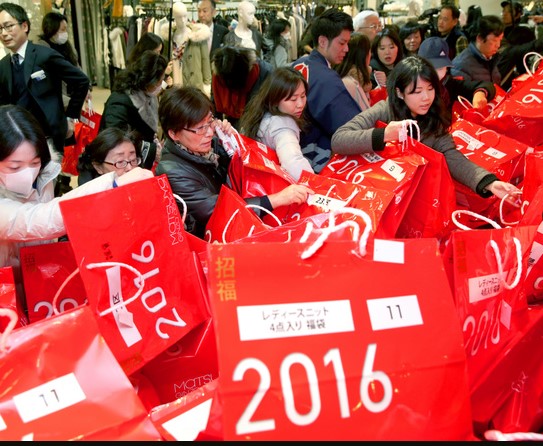
Image Credit: www.asahi.com
#3. IT HAS A RELIGIOUS MEANING
Oshougatsu is a spiritual and sacred time when the majority of the locals prefer to spend this time in relative tranquility – it is deeply related to their religions of Buddhism and Shintoism. There are no fireworks, nor crazy household parties resulting in a mess!
First of all, the locals want their home to be tidy and clean. Not just each household but also the temples and shrines, and historical castles, which all have a big cleansing at the end of the year.
When the big cleansing is over, they set traditional ornaments called kado-matsu (門松), a decoration placed in pairs in front of homes to welcome the new year god. Typically they are made of pine(松), bamboo(竹), and sometimes ume(梅) tree sprigs. They are a set of happy symbols and called “syou-chiku-bai ( 松竹梅)”. They are often used for other happy occasions as well.
Another typical decoration to put up is “shime-nawa (しめ縄 ) “ . This is to be hung at the front door in each household. This is to show that the house is sacred, and to protect the house from evil spirits.
There are some rules when placing these. For instance, the ornaments are supposed to be up by the 28th of December, otherwise it will bring bad luck. They also believe that cleaning on the new year’s day will sweep the god and the luck away.
When midnight approaches, Buddhist temples nationwide start ringing their bells, and continue into the early hours of New Year’s Day. It is called “Joya-no-kane ( 除夜の鐘 /Bells on New Year’s Eve)”. “Jo(除) ” means “to get rid of the old and move to the new”. They ring the bells 108 times, the same number of “bonnou (煩悩 /worldly desires), which are believed to cause human suffering. They believe that each bell sound eases one of your 108 bonnou so that you can start the New Year feeling refreshed.
Some people visit temples to hear the bells. Personally, I like to stay home and hear the bells at home. There is at least one temple in every area (the temple bells used to be rang to tell the time for the locals, so everyone should be able to hear it), you can hear them echo in the sky. Even if you are far away from any of those temples, you can still hear them on TV.
On New Year’s day, many people go to temples and Shinto shrines for hatsumoude(初詣/ the first visit to temple and shrine) and make a wish for the new year. Popular temples and shrines have over 3 million people during the first three days of January. If you would like to experience hatsumoude, it will be good to know that there will be a lot of waiting time in a big crowd of people just like the picture below.
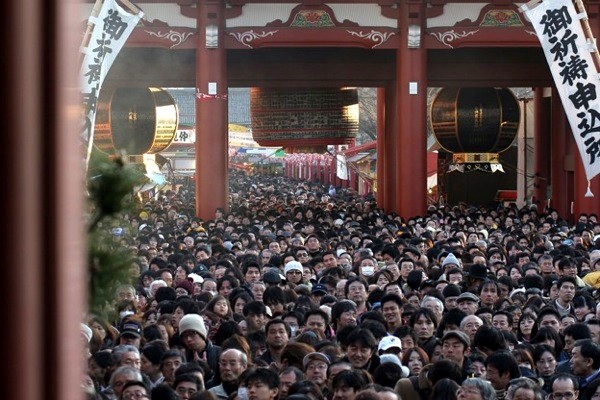
Image Credit: kirarian.com
#4. IT IS A FAMILY OCCASION
There are two times of family occasion in a year: bon and oshougatsu(盆とお正月).
Traditionally, these are the time to pay their respects to their ancestors and pray for successful crops. Nowadays, however, unlike bon, oshougatsu has more connection with gods, or generally celebrated as simply as the start of the new year, especially among younger generation.
It is an exciting time for everyone including young children. One of the excitement for children would be “Otoshidama (お年玉)”, which is a gift money that is given by parents, grandparents and relatives who spend this time together.
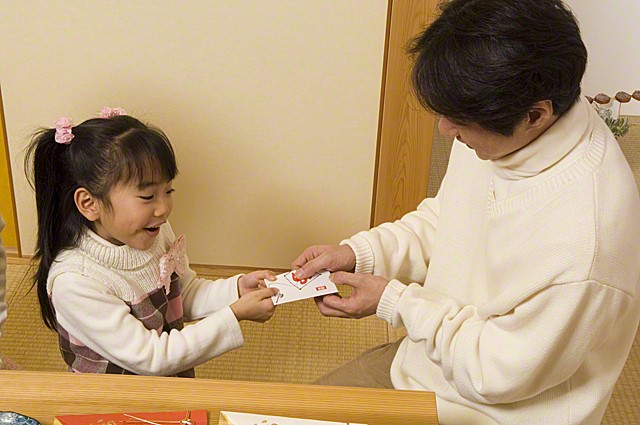
Image Credit: Mamasup.me
As the new year approaches, they start singing the song “oshougatsu (お正月)”.
“ Mou ikutsu neruto oshougatsu ( もういくつねるとお正月/How many more nights until Shougatsu? )”
The lyric goes on as follows:
“Oshougatsu niwa tako agete, koma o mawashite asobimasyo (お正月には、たこあげて、こまをまわして あそびましょ/ Let’s fly the kite and play with tops)” .
Although the way kids play has changed as the year goes by, parents try to pass the tradition to the next generation. Besides kites and tops, there are many other toys and games that are typical at this time of the year.
#5. THINGS THAT BRING GOOD LUCK
There is one thing in common among the three items listed below. What could it be?
- Fuji-san (富士山/Mt.Fuji)
- Taka (鷹 /Eagle)
- Nasu (なす/Eggplant)
Those three might look irrelevant from one another, but the locals would figure out the connection instantly.
Hatsu-yume (初夢/ year’s first dream). Hatsu (初) means “the first time”. Hatsu-yume is the first dream of the year. If your dream has either Fuji-san or Taka or Nasu, that means the new year is going to be wonderful.
Normally, people stay up and do not get much sleep on the night of the 31st of December. Thus, it is one you dream on the night of the 1st.
Hatsu-hinode (初日の出 / the first sun-rise) is another good luck thing that the locals want to see on shougatsu to make a wish.
#6. NEW YEAR FOOD
There are some special foods that Japanese people eat on this occasion. I am writing about the two significant foods here.
Osechi (おせち) is a colorful dishes packed in layers of lacquer boxes. Each dish and ingredient in osechi has meanings, such as long life, prosperity, good health, good harvest and so on. You can find simple home-cooked recipes such as osechi on Cookpad.
It is prepared prior to Shougatsu to give mothers (and to the god of the kitchen stove) some rest from cooking chores on Shougatsu. Traditionally, cooked with vinegar, salt or sugar or died so that they can be preserved for a few days without being refrigerated or cooked before eating. Lately, as families become smaller, it is time consuming to cook all of them in traditional way, and lately more and more people buy the cooked osechi at stores.
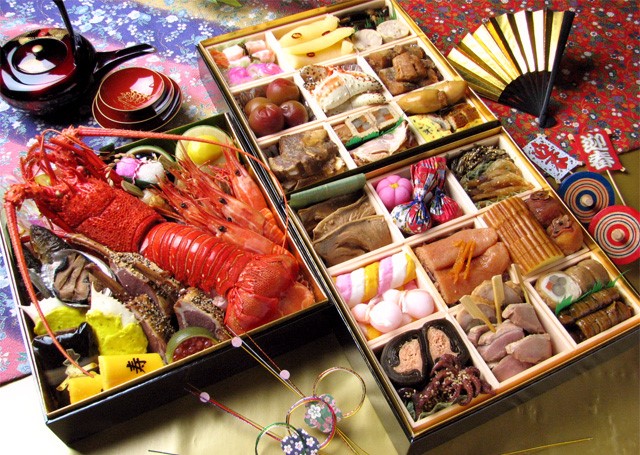
Image Credit: Mamasup.me
Mochi (もち/ sticky rice cake) is eaten on happy occasion traditionally, as it has a meaning of longevity. It used to be prepared in wooden cooking utensils called kine ( きね) and usu ( うす ). Nowadays, people cook them in a special cooking machine or just buy them at shops. Mochi is cooked in many ways, but most typical way is to be cooked in zouni (雑煮/ vegetable soup with rice cake).
Most importantly, mochi is prepared not just for eating but for Kagami-mochi (鏡餅/Mirror-shaped rice cakes), which is an offering to invite the god of the new year.
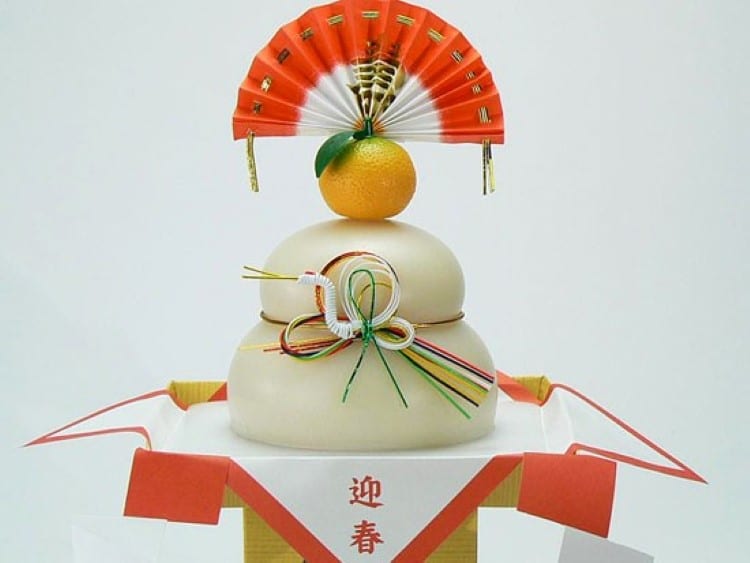
Image Credit: jpninfo.com
#7. NEW YEAR POST CARDS
Many people look forward to receiving Nen-ga-jou (年賀状 / new year post cards) from friends and family. The post office start selling new year post cards from November, so that people start preparing for those cards early enough to post them. These cards have lottery numbers on the bottom of the cards. Some people design post cards on your own, others order design for printing companies. People choose to have the design of happy symbols or twelve horary signs called Juuni-shi (十二支). The year of 2017 is the year of roosters, hence majority of postcards will have roosters on them. You cannot use the card from a year before for that reason.
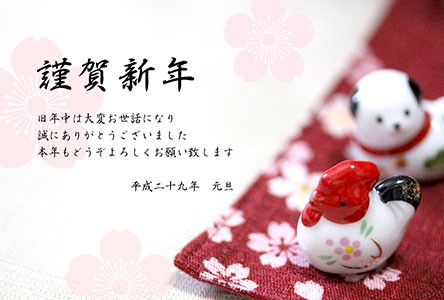
Image Credit: nengajou.andanteweb.net
Typical words on the cards are “Kinga Shinnen (謹賀新年/New Year’s Greeting)” or “ Gei shun (迎春/Welcome Spring)”, which are both for writing.
Those of you who are learning Japanese, you can use the following greetings, “Shin-nen Akemashite Omedetougozaimasu (新年あけましておめでとうございます)” and “Kotoshi (Hon-nen) mo yoroshiku onegai itashimasu (今年(本年)もよろしくお願いいたします) .
These are the important things you need to know about New Year in Japan. I wish you the best for the new year and 今年もよろしくお願いいたします.

